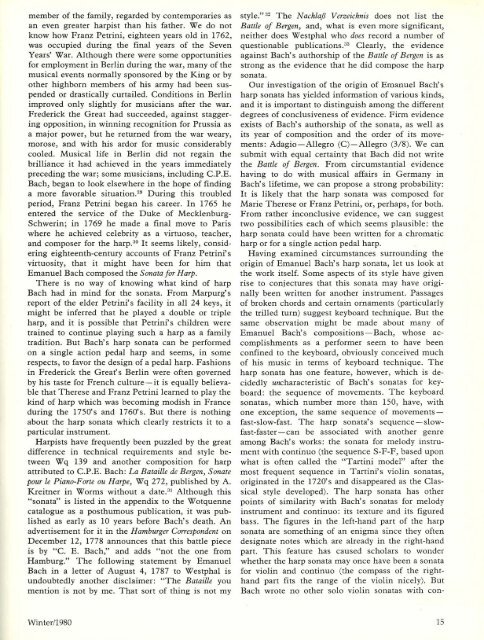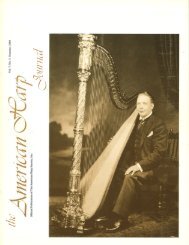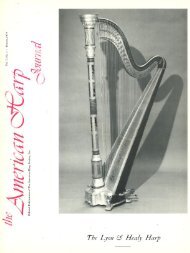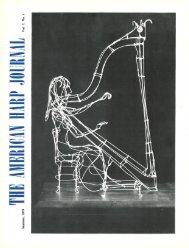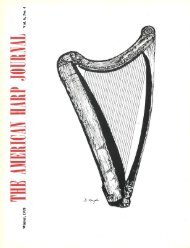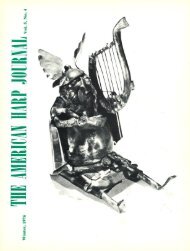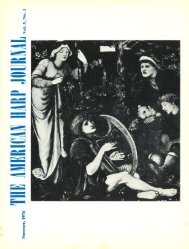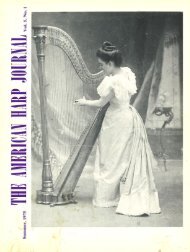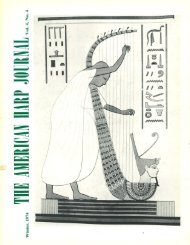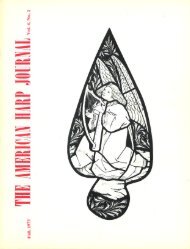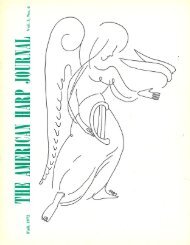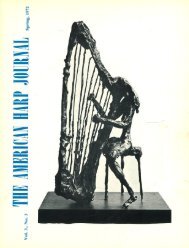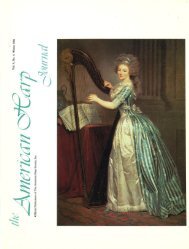Create successful ePaper yourself
Turn your PDF publications into a flip-book with our unique Google optimized e-Paper software.
member of the family, regarded by contemporaries as<br />
an even greater harpist than his father. We do not<br />
know how Franz Petrini, eighteen years old in 1762,<br />
was occupied during the final years of the Seven<br />
Years' War. Although there were some opportunities<br />
for employment in Berlin during the war, many of the<br />
musical events normally sponsored by the King or by<br />
other highborn members of his army had been suspended<br />
or drastically curtailed. Conditions in Berlin<br />
improved only slightly for musicians after the war.<br />
Frederick the Great had succeeded, against staggering<br />
opposition, in winning recognition for Prussia as<br />
a major power, but he returned from the war weary,<br />
morose, and with his ardor for music considerably<br />
cooled. Musical life in Berlin did not regain the<br />
brilliance it had achieved in the years immediately<br />
preceding the war; some musicians, including C.P.E.<br />
Bach, began to look elsewhere in the hope of finding<br />
a more favorable situation. 29 During this troubled<br />
period, Franz Petrini began his career. In 1765 he<br />
entered the service of the Duke of Mecklenburg<br />
Schwerin; in 1769 he made a final move to Paris<br />
where he achieved celebrity as a virtuoso, teacher,<br />
and composer for the harp. 30 It seems likely, considering<br />
eighteenth-century accounts of Franz Petrini's<br />
virtuosity, that it might have been for him that<br />
Emanuel Bach composed the Sonata for Harp.<br />
There is no way of knowing what kind of harp<br />
Bach had in mind for the sonata. From Marpurg's<br />
report of the elder Petrini's facility in all 24 keys, it<br />
might be inferred that he played a double or triple<br />
harp, and it is possible that Petrini's children were<br />
trained to continue playing such a harp as a family<br />
tradition. But Bach's harp sonata can be performed<br />
on a single action pedal harp and seems, in some<br />
respects, to favor the design of a pedal harp. Fashions<br />
in Frederick the Great's Berlin were often governed<br />
by his taste for French culture - it is equally believable<br />
that Therese and Franz Petrini learned to play the<br />
kind of harp which was becoming modish in France<br />
during the l 750's and l 760's. But there is nothing<br />
about the harp sonata which clearly restricts it to a<br />
particular instrument.<br />
Harpists have frequently been puzzled by the great<br />
difference in technical requirements and style between<br />
Wq 139 and another composition for harp<br />
attributed to C.P.E. Bach: La Bataille de Bergen, Sonate<br />
pour le Piano-Forte ou Harpe, Wq 272, published by A.<br />
Kreitner in Worms without a date. 31 Although this<br />
"sonata" is listed in the appendix to the Wotquenne<br />
catalogue as a posthumous publication, it was published<br />
as early as 10 years before Bach's death. An<br />
advertisement for it in the Hamburger Correspondent on<br />
December 12, 1778 announces that this battle piece<br />
is by "C. E. Bach," and adds "not the one from<br />
Hamburg." The following statement by Emanuel<br />
Bach in a letter of August 4, 1787 to Westphal is<br />
undoubtedly another disclaimer: "The Bataille you<br />
mention is not by me. That sort of thing is not my<br />
style." 32 The Nachla/3 Verzeichnis does not list the<br />
Battle of Bergen, and, what is even more significant,<br />
neither does Westphal who does record a number of<br />
questionable publications. 33 Clearly, the evidence<br />
against Bach's authorship of the Battle of Bergen is as<br />
strong as the evidence that he did compose the harp<br />
sonata.<br />
Our investigation of the origin of Emanuel Bach's<br />
harp sonata has yielded information of various kinds,<br />
and it is important to distinguish among the different<br />
degrees of conclusiveness of evidence. Firm evidence<br />
exists of Bach's authorship of the sonata, as well as<br />
its year of composition and the order of its movements:<br />
Adagio-Allegro (C)-Allegro (3/8). We can<br />
submit with equal certainty that Bach did not write<br />
the Battle of Bergen. From circumstantial evidence<br />
having to do with musical affairs in Germany in<br />
Bach's lifetime, we can propose a strong probability:<br />
It is likely that the harp sonata was composed for<br />
Marie Therese or Franz Petrini, or, perhaps, for both.<br />
From rather inconclusive evidence, we can suggest<br />
two possibilities each of which seems plausible: the<br />
harp sonata could have been written for a chromatic<br />
harp or for a single action pedal harp.<br />
Having examined circumstances surrounding the<br />
origin of Emanuel Bach's harp sonata, let us look at<br />
the work itself. Some aspects of its style have given<br />
rise to conjectures that this sonata may have originally<br />
been written for another instrument. Passages<br />
of broken chords and certain ornaments (particularly<br />
the trilled turn) suggest keyboard technique. But the<br />
same observation might be made about many of<br />
Emanuel Bach's compositions - Bach, whose accomplishments<br />
as a performer seem to have been<br />
confined to the keyboard, obviously conceived much<br />
of his music in terms of keyboard technique. The<br />
harp sonata has one feature, however, which is decidedly<br />
uncharacteristic of Bach's sonatas for keyboard:<br />
the sequence of movements. The keyboard<br />
sonatas, which number more than 150, have, with<br />
one exception, the same sequence of movements -<br />
fast-slow-fast. The harp sonata's sequence-slowfast-faster-can<br />
be associated with another genre<br />
among Bach's works: the sonata for melody instrument<br />
with continuo (the sequence S-F-F, based upon<br />
what is often called the "Tartini model" after the<br />
most frequent sequence in Tartini' s violin sonatas,<br />
originated in the 1720' s and disappeared as the Classical<br />
style developed). The harp sonata has other<br />
points of similarity with Bach's sonatas for melody<br />
instrument and continuo: its texture and its figured<br />
bass. The figures in the left-hand part of the harp<br />
sonata are something of an enigma since they often<br />
designate notes which are already in the right-hand<br />
part. This feature has caused scholars to wonder<br />
whether the harp sonata may once have been a sonata<br />
for violin and continuo (the compass of the righthand<br />
part fits the range of the violin nicely). But<br />
Bach wrote no other solo violin sonatas with con-<br />
<strong>Winter</strong>/<strong>1980</strong><br />
15


